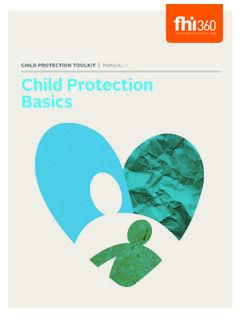Transcription of Early marriage, pregnancy and girl child school dropout
1 The K4D helpdesk service provides brief summaries of current research, evidence, and lessons learned. Helpdesk reports are not rigorous or systematic reviews; they are intended to provide an introduction to the most important evidence related to a research question. They draw on a rapid desk-based review of published literature and consultation with subject specialists. Helpdesk reports are commissioned by the UK Department for International Development and other Government departments, but the views and opinions expressed do not necessarily reflect those of DFID, the UK Government, K4D or any other contributing organisation.
2 For further information, please contact Helpdesk Report Early marriage , pregnancy and girl child school dropout Jenny Birchall Independent researcher and consultant October 2018 Question What evidence is there from any context in low and middle income countries that Early marriage and/or pregnancy increases rates of girl child dropout ? In particular, what available evidence is there about laws, policies and practices that force pregnant girls or new mothers out of school ? Contents 1. Summary 2. Evidence availability and interpretation 3. Regional differences and distinctions 4. Policies around Early pregnancy and education 5. Practices, attitudes and behaviours around Early pregnancy and education 6.
3 References 2 1. Summary Although Early marriage and pregnancy are often linked to school dropout , evidence proving a direct and causal link is limited. This is because Early marriage and pregnancy can be both the cause and consequence of dropping out of school . Girls certainly leave or are taken out of school because they are pregnant or married, but girls who have already dropped out of school are more likely to marry and/or become pregnant. There is a significant body of evidence looking at the links between Early pregnancy (often outside of marriage ) and school dropout in Sub-Saharan Africa, and there are some studies that consider the relationship between Early marriage (and resulting Early pregnancies) and school drop out in South Asia.
4 Key points emerging from this evidence include: There is a body of evidence to suggest that girls who become pregnant or are married Early may already have been performing poorly at school , have started school late or have experienced barriers to academic achievement which increase the likelihood of an Early marriage or pregnancy . Social and economic pressures on families and on girls themselves play a part. The majority of studies draw attention to a complex combination of factors behind girl child school dropout , including: poverty, pregnancy , Early marriage , gendered social norms prevalent within communities, peer influence, parental influence, family size, lack of hygiene facilities and lack of trained teacher counsellors.
5 Available evidence reflects important regional differences and distinctions. In South Asia, the majority of Early pregnancies arise within marriage , whereas in Latin America and the Caribbean there are higher rates of Early pregnancy outside of marriage . In Sub-Saharan Africa there are high rates of Early pregnancy both within and outside of marriage (UNESCO, 2017). Evidence is readily available on policies that exclude pregnant students from school , and those that support new mothers re-entry into school in Africa. 26 countries in the African Union have some type of law, policy or strategy in place to guarantee girls rights to education during or after pregnancy . In a minority of countries, there are policies or laws that explicitly allow pregnant students and new mothers to be excluded from school (Martinez and Odhiambo, 2018).
6 There are also a number of studies that examine the impact of more informal practices, behaviours and attitudes around and towards pregnant students for example as displayed by teachers, other students, families and communities on the likelihood of girls who are pregnant or new mothers dropping out of school . The majority of these studies are focused on countries in Sub-Saharan Africa. The majority of the available evidence on this topic comes from Sub-Saharan Africa, particularly when looking at Early pregnancy . Despite the fact that a large proportion of girls affected by child marriage live in South Asia, it was much more difficult to find evidence from this region on links between child marriage and school dropout .
7 National data, such as those collected by the Demographic and health Surveys, provide information on the number of girls and women who complete different levels of education. They also allow analysis of the proportion of girls aged 15-19 who have begun childbearing, and the percentage of women who were married before age 15. (Croft, et al. 2018). Datasets for some countries also have information on the number of girls and young women aged 15-19 who are pregnant with their first child , have had a live birth, or 3 have begun childrearing, disaggregated by level of education. However, they do not show whether girls and young women dropped out of education before or after they married or became pregnant.
8 They also do not help us understand the experiences of girls under the age of 15. Another factor to consider around evidence is that many of the most commonly cited studies are a decade old or more. More recent studies have been produced in the last two years which shed fresh light onto the topic, although they come to similar conclusions about the non-linear relationships between Early marriage , pregnancy and school dropout . While it is clear that Early pregnancy and marriage play an important part in girl child school dropout , the different perimeters of available studies, combined with a lack of robust, comparable national data, and the fact that Early marriage and pregnancy , as well as school dropout , are so interlinked with socioeconomic inequalities and unequal gender norms, means it is difficult to make simple causal assumptions about exactly how Early marriage and pregnancy influence school dropout .
9 2. Evidence availability and interpretation When looking at the links between Early and child marriage , Early pregnancy , and girls school dropout , it is important to recognise and take account of the different types of evidence and analyses available. Some research and data focuses on Early and unintended pregnancy , some on Early marriage , and some look at both together. While often these two topics are intertwined, they also need to be looked at separately in other circumstances. Around 90 per cent of adolescent pregnancies in low and middle income countries occur in girls who are married (UNFPA, 2013). This is due to married girls higher exposure to sex, lower use of contraception, and pressure to conceive quickly after marriage (Psaki, 2012 p.)
10 112). However, the risk of unplanned pregnancy is growing for unmarried girls as the legal age for marriage increases globally, having some but not an automatic impact on marriage practices (Psaki, 2012 p. 112). There is a significant body of evidence looking at the links between Early pregnancy (often outside of marriage ) and school dropout in Sub-Saharan Africa, but the findings from these studies are not necessarily relevant for, or do not necessarily align with, studies looking at the relationship between Early marriage (and resulting Early pregnancies) and school drop out in South Asia (see section three below for more on regional differences). The different perimeters of available studies, along with a lack of robust, comparable national data, and the fact that Early marriage and pregnancy , as well as school dropout , are so interlinked with socioeconomic inequalities and unequal gender norms, make it difficult to make causal assumptions about exactly how Early marriage and pregnancy influence school dropout .
















